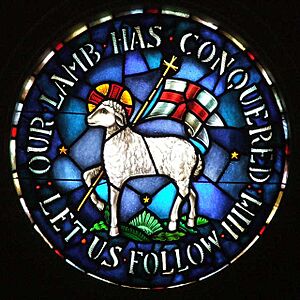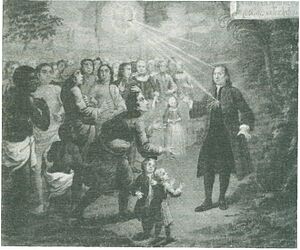History of the Moravian Church facts for kids
The Moravian Church is one of the oldest Protestant churches in the world. It began in the 15th century in what is now the Czech Republic. This article will tell you about its history, from its early days to its important mission work around the world. We'll also learn about their first settlements in Pennsylvania, USA.
Contents
History of the Moravian Church
Early Beginnings (15th Century)
The Moravian Church started with a Catholic priest named Jan Hus in the early 1400s. He wanted to change some things in the Roman Catholic Church in his home countries of Bohemia and Moravia. Hus believed that church services should be in the language people understood, not just Latin. He also thought everyone should receive both bread and wine during communion.
After Hus died, his followers split into different groups. Some made a deal with the Roman Catholic Church, but others continued to follow Hus's ideas. These people became known as the 'Bohemian Brethren' or 'Unity of the Brethren'. They officially formed their own church in Kunvald, Bohemia, in 1457. This was about 50 years before Martin Luther started the Protestant Reformation!
Growth and Education (16th Century)
The Moravians were pioneers in many ways. One surprising belief for their time was their focus on education for everyone. By the mid-1500s, most people in the Czech lands were Protestant. The Moravian Church set up many schools and printing shops, which helped their ideas spread.
Local nobles often protected the Brethren, helping them stay independent from the powerful Habsburg rulers. Many towns had Protestant schools, some even teaching advanced subjects like Latin, Greek, and Hebrew. This strong focus on learning was a big part of their early success.
Challenges and Hiding (17th Century)
In 1609, the emperor Rudolf II signed a special paper called the Letter of Majesty. This paper promised religious freedom in Bohemia. But things changed when Ferdinand of Styria, a strong Catholic, became emperor.
In 1618, Protestant nobles started a revolt because they feared losing their religious freedom. They lost the battle in 1620. As a result, many Protestants were forced to leave their homes or secretly practice their faith. The Brethren had to go underground, meaning they met and worshipped in secret. Many moved to other parts of Europe, like Poland. Bishop John Amos Comenius tried to keep their faith alive during these tough times.
A New Start and Missions (18th Century)
In 1700, a kind nobleman named Nicolaus Ludwig Zinzendorf was born in Dresden, Germany. He was very interested in religious ideas and wanted to create a model Christian community on his land.
In 1722, Zinzendorf welcomed persecuted Protestants from Moravia to settle on his estate. Among them were members of the old Bohemian Brethren who had been hiding their faith for nearly 100 years. These refugees built a new village called Herrnhut.
At first, there were some arguments in the community. But in 1727, something amazing happened. The people of Herrnhut felt a strong spiritual renewal and "learned to love one another." This experience brought them together and helped their community grow rapidly.
Herrnhut became a center for Christian renewal and mission work. Here are some of their big achievements:
- They started a "prayer watch" that lasted for 100 years, with someone praying 24 hours a day!
- They began publishing the Losungen, or "Daily Watchwords," in 1728. These are daily Bible verses still read in 50 languages today.
- They created over 30 new settlements around the world, based on the Herrnhut model. These communities focused on prayer, simple living, and sharing wealth.
- They sent out hundreds of Christian missionaries to faraway places like the Caribbean, North and South America, Africa, and the Arctic.
- Moravian missionaries were the first large-scale Protestant mission movement. They were also the first to send ordinary people (not just trained clergy) and the first to work with enslaved people. The first missionaries went to the island of St Thomas in 1732.
- They formed many small groups within other churches in Europe, encouraging personal prayer and Bible study.
Moravians in Pennsylvania

Before settling in Pennsylvania, the Moravians first tried to set up a mission in Georgia. But because of problems like upcoming wars, some of them moved to Bethlehem, Pennsylvania in 1740.
The Moravians who settled in Bethlehem were part of this ancient church that began in 1457 in the Czech Republic. Their main goal in the colonies was to share their faith with the Native Americans in the Delaware River area.
Today, the Moravian Church has about 825,000 members worldwide. They still follow many traditions from the 18th century, like the "lovefeast" (a simple meal shared together) and traditional music. In some older communities, Moravians are buried in special graveyards called "God's Acre," organized by gender and age.
They continue their mission work in places like the West Indies and Greenland. The Moravian Church in America also sponsors Moravian College and Seminary, one of the oldest colleges in the United States. The largest number of Moravians today live in Tanzania, Africa.
The motto of the Moravian church is:
- (in Latin) In necessariis unitas, in dubiis libertas, in omnibus caritas
- (in English) "In essentials, unity; in nonessentials, liberty; and in all things, love."
Later Years (19th and 20th Centuries)
In the 1800s, some Hussite immigrants (followers of Jan Hus) came to the United States and formed the Unity of the Brethren in Texas.
In the Czech Republic, the Brethren who had stayed during the Catholic persecution slowly gained some religious freedom in 1781. However, they couldn't restart their own independent church right away. They had to join other Protestant churches. Later, in 1918, these groups united to form the Evangelical Church of Czech Brethren.
In 1920, the Czechoslovak Hussite Church was formed in the newly created country of Czechoslovakia. This church wanted to continue the traditions of Jan Hus. By the 1950s, it had over a million members.
See also
- Religious peace of Kutná Hora


